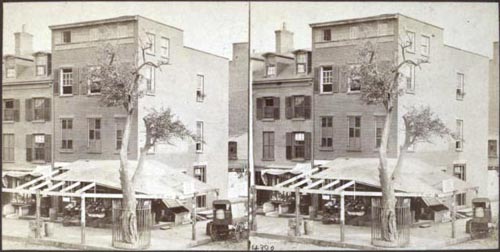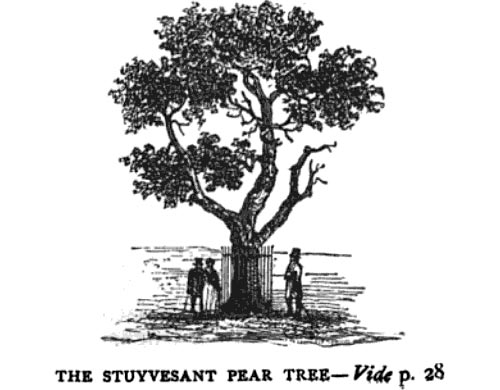Peter Stuyvesant’s pear tree
Peter Stuyvesant was the director-general of the New Netherlands colony from 1647 to 1664, when the Dutch lost it to the British and New Amsterdam became New York. When Stuyvesant arrived in New Amsterdam, he brought a pear tree with him and planted it on his farm, which encompassed much of what is now the East Village. After a trip to Amsterdam following the English takeover of the colony, Stuyvesant returned to his farm in New York, where he lived until his death in 1672.
His pear tree persevered. As Manhattan’s grid sprang up around it, the tree remained bearing fruit on the corner of 13th Street and 3rd Avenue. Here’s a stereoscopic photo of the tree from the 1860s.

In 1867, over 200 years after the tree was planted, the last known living link to the Dutch rule of Manhattan was felled by a vehicle collision. The NY Times ran a short piece about the death of the tree: Untimely End of the Stuyvesant Pear-Tree.
The well-known pear-tree planted by Gov. Stuyvesant, and which has stood for two centuries, came at last to a sudden demise during the latter part of last week. This old and famous tree stood on the corner of Thirteenth-street and Third-avenue, in a circular enclosure of iron railing, erected, we believe, by Mr. Wainwright, a descendant of the old Dutch Governor. It had its traditions, though it was less renowned than the famous Charter Oak of Connecticut, but like that old tree, it had been made the subject of many a sketch. Its decay was marked year by year in the declining average of its blossoms, but it was not considered beyond bearing before the occurrence of an accident which cleft the ancient trunk in twain. The destruction of this old landmark is stated to have resulted from a collision of vehicles, one of which was thrown against the tree with sufficient force to break it down. Laborers were engaged in removing the limbs and trunk yesterday, which were proclaimed obstructions to travel.
I found one of those many sketches in a book called History of the School of the Collegiate Reformed Dutch Church in the City of New York, from 1633 to 1883.

A plaque now marks the corner where the tree stood and in 2003, a new pear tree was planted in the same spot, hopefully to live for another 200 years.
N.B. From what I can tell from my research, the plaque may be wrong about the date that the tree was planted. It states that Stuyvesant brought the tree back with him after the English took control of New Amsterdam in 1664 whereas most other sources on the matter indicate that Stuyvesant brought the tree with him when he came to assume control of the colony in 1647.





Stay Connected